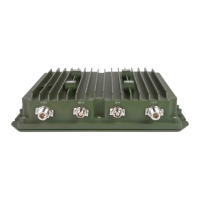3-32
RF-7800W
SYSTEM ADMINISTRATION AND CONFIGURATION
3.9.3.2 Burst Rate
When adaptive modulation is not used, a single set of downlink and uplink burst rates must be configured. If the
burst rate is set too high for a given link budget, it will be difficult to initiate and maintain a reliable link. When
adaptive modulation is used, maximum and minimum downlink and uplink burst rates must be configured. The radio
will attempt to stay above the minimum, but will adapt to lower modulations if link conditions deteriorate. Refer to
Table 3-5.
3.9.4 Information Rate
The Committed Information Rate (CIR) defines a link's minimum required user data rate. The Peak Information Rate
(PIR) defines a link's maximum allowed user data rate. On a per-link basis, there are separate CIR and PIR values
for both the downlink and uplink. The SC uses these values to assist with prioritizing how much traffic is sent over
each link when there is not enough transmission time to get all data to all subscribers. The SC will attempt to ensure
that the CIR is met on all subscribers, but may be forced to proportionally scale them if link conditions deteriorate
and the burst rate is not able to support them.
Table 3-5. Burst Rates per Channel Width
Modulation/
Coding
Burst Rate per Channel Width
5 MHz 10 MHz 20 MHz 40 MHz
SISO/
MIMO-A
BPSK 1/2 2 4 8 17
QPSK 1/2 4 8 17 34
QPSK 3/4 6 12 25 51
16-QAM 1/2 8 17 34 68
16-QAM 3/4 12 25 51 102
64-QAM 2/3 17 34 68 136
64-QAM 5/6 21 42 85 170
256-QAM 3/4 25 51 102 204
256-QAM 7/8 29 59 119 238
MIMO-B
BPSK 1/2 4 8 17 34
QPSK 1/2 8 17 34 68
QPSK 3/4122551102
16-QAM 1/2 17 34 68 136
16-QAM 3/4 25 51 102 204
64-QAM 2/3 34 68 136 272
64-QAM 5/6 42 85 170 340
256-QAM 3/4 51 102 204 408
256-QAM 7/8 59 119 238 476

